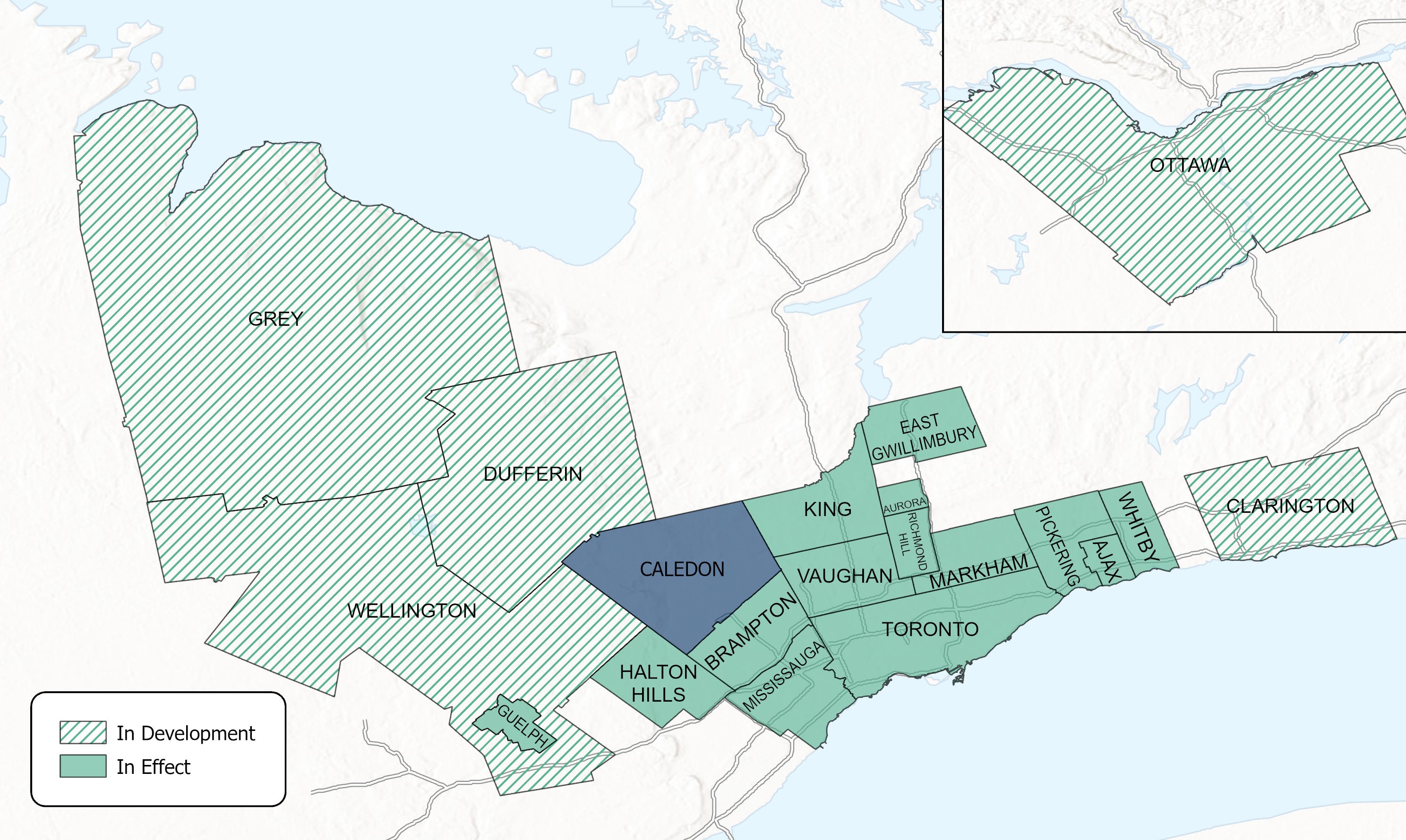Green Development Standards
About Green Development Standards
Green Development Standards (GDS) are climate-friendly measures implemented by municipalities to encourage sustainable community design. These standards are integrated into the planning approvals process for development applications.
On January 28, 2020, Town of Caledon Council unanimously passed a motion declaring a climate change emergency and committing to achieve net-zero greenhouse gas emissions community-wide by 2050 and enhancing resiliency to climate change impacts. This commitment was solidified in the Resilient Caledon Community Climate Change Action Plan released in 2021, which outlined a strategic roadmap to reach the net-zero target.
One of the pivotal actions outlined in the plan was the development and implementation of a green development standard to ensure all new buildings achieve net-zero and are climate-resilient by 2030, promoting efficient, green, and livable community design. With Caledon's population expected to triple by 2051 and the imperative need to address climate change, Green Development Standards are crucial.
Key benefits include:
- Reduced energy use and greenhouse gas emissions from buildings and transportation
- Increased preparedness of buildings and neighborhoods to climate impacts
- Improved health and well-being of residents
- Better quantity and quality of green space in urban areas
- Cost savings for residents and businesses (i.e. lower energy and utility costs)
This two-year effort involved extensive research, engagement, and collaboration with stakeholders and neighboring jurisdictions to tailor a standard that aligns with the Town's specific needs and climate goals.
Other municipalities with green standards
The City of Toronto created the first green standard with mandatory energy and GHG emissions targets for buildings in in 2010. The majority of municipalities in the Greater Toronto Area (GTA) now have, or are in the process of developing, green standards.

Applicability
GDS apply to Site Plan and Draft Plan of Subdivision applications for residential, commercial, and industrial developments across Caledon. Exceptions to these are noted in the GDS Guidebook.
Implementation
The GDS will be effective starting July 1, 2024 for all new development applications. It will roll out as part of a one-year pilot phase so that staff can evaluate implementation, receive feedback from applicants and internal reviewers, and make minor adjustments to the metrics or process after the pilot phase concludes.
GDS Goals and Metrics
Theme 1: Community Design and Mobility |
||||||||
|
Objective: Create safe and interconnected routes that encourage active and sustainable transportation modes, and incorporate public spaces for social interaction and recreational activities. This approach supports diverse building types, both residential and non-residential, and promotes compact development to reduce reliance on private vehicles. The goal is to provide alternative transportation options for residents and visitors. These efforts align with Caledon's various plans and strategies, such as the Active Transportation Master Plan, Town-Wide Design Guidelines, Recreation & Parks Master Plan, Age-Friendly Caledon Action Plan, and Official Plan, fostering a sustainable and accessible environment for all.
|
||||||||
Theme 2: Green Infrastructure |
||||||||
|
Objective: Prioritize residents' well-being and the health of communities by enhancing urban green spaces and tree canopy. This approach helps improve air quality, cooling, and physical and mental health, while also protecting biodiversity and creating habitats for wildlife. The theme area emphasizes the role of green infrastructure in managing stormwater and the general well-being of the site. The 'On-Site Green Infrastructure' metric, inspired by Seattle's Green Factor, offers a flexible catalogue of features to improve green cover quantity and quality, aligning with Caledon's climate action plans and conservation objectives.
|
||||||||
Theme 3: Buildings and Energy |
||||||||
|
Objective: Support low carbon, energy efficient, and resilient buildings and renewable energy systems. Building operations account for almost one-third of GHG emissions in Caledon. The metrics in this theme will support the Town’s climate change target of all new buildings constructed to net zero emissions by 2030 and ensure that buildings are resilient to climate change impacts like flooding, extreme heat, extreme wind, and power disruptions.
|
Resources
- GDS Guidebook
- Applicant Checklists:
General Tools and Templates |
|
Embodied Carbon Reporting Tool Owner Education Terms of Reference |
Energy Modelling |
Energy Reporting for Low Rise Residential
Energy Reporting for Other Buildings |
Building Resiliency Strategy |
|




 Subscribe to this page
Subscribe to this page